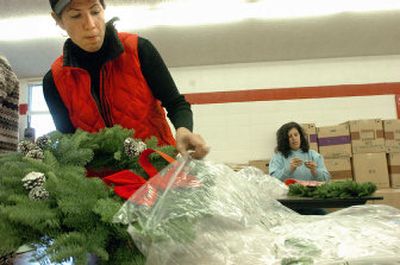Fund-raisers get creative

Gone are the days when school fund raising simply meant bake sales and concession stands.
With ever tightening budgets, schools and parent organizations in North Idaho have broadened the scope of money-making and gotten creative.
Cereal boxes helped raise about $900 last year for Ponderosa Elementary School in Post Falls. Under the Box Tops for Education program, coupons found on certain brands of products can be redeemed for cash. Most of those submitted to the school have been from breakfast foods.
“It all adds up,” said Principal Kathy Baker. “And it makes a big difference.”
The school has bought items such as art supplies, portable white message boards and copy machine toner with the money raised by its various fund-raisers.
“There’s just not the money in our site budget to meet our needs,” Baker said.
At Bryan Elementary in Coeur d’Alene, fourth-grade teachers are collecting used cell phones to raise money for a visit to the Legislature in Boise.
The teachers will send the phones to a recycling company, which will then give money based on the gadgets’ individual values. Most donated cell phones will yield $1, said teacher Michelle Faucher-Sharples, who thinks the experience is a positive way to emphasize recycling. She is optimistic about the trip’s prospects. Depending on the amount raised by March, the fourth-graders will travel by train, bus or plane.
The parent organization at Canfield Middle School in Coeur d’Alene has tried selling things to parents that they would ordinarily buy anyway. So, for the past couple of years, the group has been marketing freshly-made wreaths, cookie dough and magazines. Those sales garner more than $10,000 a year for the school. Parents are encouraged to do the selling – not their kids.
Another big money-maker is selling Jamba Juice fruit drinks at lunch. Recent nutrition guidelines have meant that schools face restrictions on bake sales, concessions and cafeteria treats like milkshakes.
“You have to try to find creative ways of getting money,” said Chris Anderl, chairwoman of the parent group and mother of a seventh-grader.
Jamba Juice is acceptable under the nutrition guidelines because of its fruit content, and it has actually yielded more money than concession sales – about $2,500 a year – because kids can’t go to the grocery store across the street to get it, Anderl said.
“What people need to realize is that schools are fund-raising for a reason,” Anderl said. In the past, the money has gone toward buying projectors, replacing a 40-year-old piano and helping teachers buy supplies.
“These are extras if we didn’t fund-raise, we wouldn’t get,” Anderl said. She spends so much time coordinating the efforts that people think she is a full-time school employee. “That should be our responsibility,” Anderl added, “to make sure our kids have everything they need.”
But not everyone is a fan of school fund-raisers.
Jim Lien, principal at Coeur d’Alene’s Woodland Middle School, said he doesn’t like the idea of kids going door-to-door selling things.
Also, at most schools, students who raise the most money are given prizes at an assembly. “We don’t want to take time out of the school day,” Lien said.
But Lien doesn’t differ with others about the need for extra money.
“In education, we never have a shortage of where we can spend money in a useful way,” he said. His school doesn’t have a reader board outside, something Lien would like to have. The school is slowly raising money for that by asking for donations from parents.
But active fund raising isn’t an option.
“Once you have the money from those extra fund-raisers,” Lien said, “it’s harder to do without it than if you didn’t do it to begin with.”